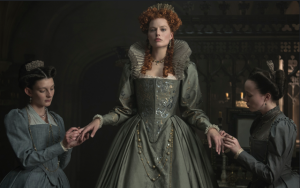MARY QUEEN OF SCOTS: 2 ½ STARS. “bogged down by narrative machinations.”
 Mr. Parker, my grade nine history teacher, believed in learning by rote. Once a day thirty schoolmates and I would assemble in his class and were invariably confronted with Mr. Parker in his black suit dusted with chalk from writing, in perfect script, three chalk boards worth of notes. “Write it down and learn it.” A mishmash of dates and names, his notes were detailed but ultimately did not bring the story to life.
Mr. Parker, my grade nine history teacher, believed in learning by rote. Once a day thirty schoolmates and I would assemble in his class and were invariably confronted with Mr. Parker in his black suit dusted with chalk from writing, in perfect script, three chalk boards worth of notes. “Write it down and learn it.” A mishmash of dates and names, his notes were detailed but ultimately did not bring the story to life.
Watching “Mary Queen of Scots,” a new historical drama starring Saoirse Ronan and Margot Robbie, I was immediately transported back to Mr. Parker’s class.
The convoluted tale begins in 1561 with Mary Stuart (Ronan) returning to Scotland being raised Catholic in France and widowed at age eighteen. She comes home to a world of intrigue. Her half-brother, the Earl of Moray (James McArdle) would seem to be an ally but holds resentment that he will lose his exalted place as King with her return. She also faces opposition from John Knox (David Tennant), a religious leader who brands the queen a harlot, unfit for the throne.
Meanwhile in England Mary’s twenty-five-year-old Protestant cousin Queen Elizabeth I (Robbie, under an inch of make-up) has a certain amount of sympathy for her long lost relative. The monarch understand what it means to be a woman ruler in a world of men but her advisers, including her chief council William Cecil (Guy Pearce) see Mary as a threat who must be dealt with.
Cue the intrigue and sharpen those axes.
There is a lot going on in “Mary Queen of Scots.” Political backbiting, betrayal, toxic patriarchy, romance, more betrayal and equal parts empathy and cruelty are all on display, making an already expansive story—it spans roughly twenty years—feel overstuffed. Locations, dates and motivations blur as the courtly manipulations pile atop one another, leaving behind a nicely acted film that feels weighted down by an excess of intrigue.
Robbie and Ronan, rivals for the Best Actress Oscar last year, share just one scene, an historically inaccurate meeting that features the film’s best moments. As Mary shifts from pleading for sisterhood to imperiously claiming the crown of England for herself—“I am a Stuart, the rightful queen.”—there is more drama in those few minutes than in the film’s entire middle section.
“Mary Queen of Scots” has some admirable, timely qualities. Colour-blind casting—most notably through the work of Gemma Chan and Adrian Lester—Mary’s attitude toward the gender-fluid minstrel David Rizzio (Ismael Cruz Cordova) and the portrayal of Mary and Elizabeth as strong willed women are thoroughly modern and to be commended. It’s too bad the narrative machinations bog down what otherwise is a fine tale of political manoeuvring.
